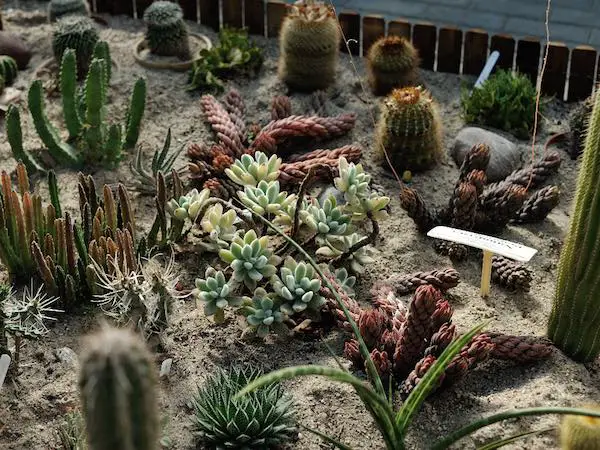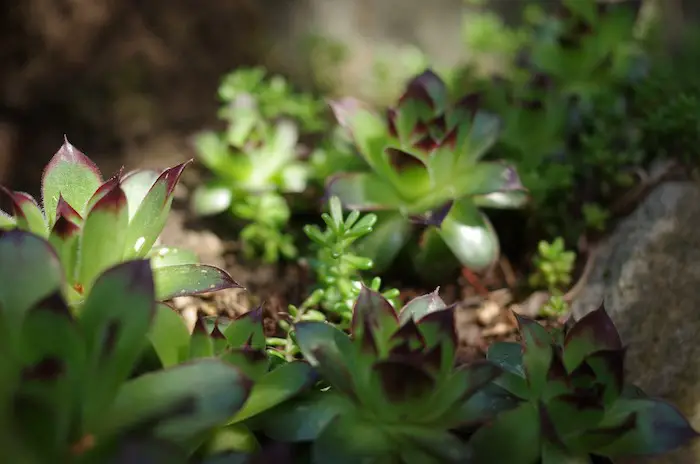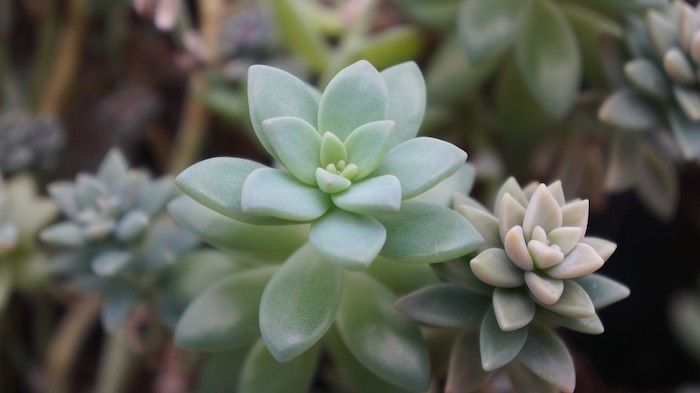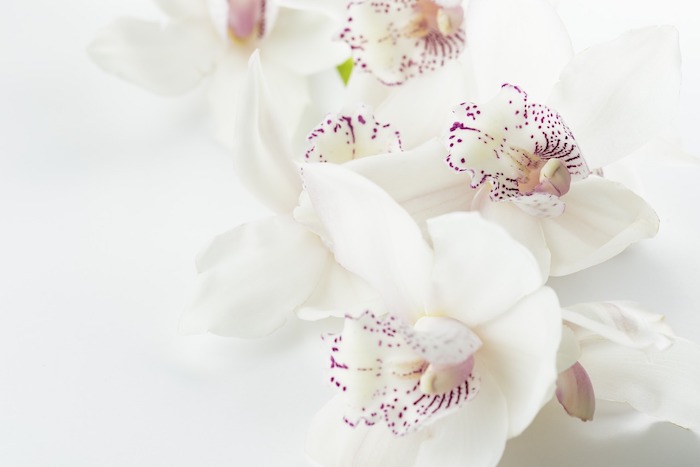Think about succulents and the mind immediately conjures up images of decorative floral structures sitting pretty on a window sill or bookshelf. While they are widely popular as indoor plants, there are a variety of outdoor succulents meant to thrive in a garden.
The beauty of having succulents in the garden is that you can grow them all year round and in almost all climates. If you live in colder regions that get harsh winters, you will just need some extra care, planning, and rotating.
Succulents have the reputation of being low maintenance plants, hence some people say they are ‘hard-to-kill’. Well, that makes us cringe because we feel that like any other plant, succulents also need care in order to thrive. They are certainly much more forgiving, but you must know the key to keep them in good health.
If you are a beginner at growing succulents, there are several things that you will need to know and have doubts about. In this extensive guide, we have included all information, tips, and ideas that you would possibly need to take care of succulents outdoors.
Where To Plant Them: Ground Or Pot
You need to start by choosing the right variety of succulents that can thrive outdoors (check the list of 5 best varieties mentioned later in the article). Planting succulents on the ground can have aesthetic value for your outdoor garden, but the question is – how practical is that?
No matter which species you choose, chances are that the outdoor succulents will not be able to survive the harsh winter frost. A few exceptions are stiff varieties like hens and chicks that go into a dormant mode in freezing temperatures. The rest will wilt and wither as the mercury drops.
So, unless you live in a warm region that does not get harsh winters, you will be better of planting succulents outdoor in pots. The advantage of growing in planters is that they can be brought indoors as the climate changes and winter sets in.
Some house owners love growing different varieties of succulents outdoors all together in large planters for a greater visual appeal. Besides the planters and pots being a much practice choice for succulents, there are also a lot of benefits associated with their use:
Growing succulents in pots allow you to control the amount of water they receive because they have delicate roots that can rot easily if over-saturated. So, if you live in a region that gets too much rain, and sudden downpours any time of the day, planters are a more practical solution to keep the plant dry.
In regions that are mostly sunny and ideal for growing succulents, such as Southern California, planters are preferred to help move the plants when there are dreadful heat waves.
Caring For Succulents in Garden Beds

If you live in a region that has a warm climate all the year round, you may consider growing outdoor succulents in the ground for visual appeal. As the plants are desert natives, they are completely tolerant of extreme weather conditions and help in cutting down water wastage. So, if you want to plant succulents in your garden bed, here are a few tips to care for them:
- Make sure you plant them in the ground with well-draining soil to save the root from rotting. We suggest that you create a 6” mound on the ground and plant succulents in the mound.
- If you are planting a variety that has a tendency to spread out as they mature, make sure you leave enough space in between the plants.
- Once you have properly planted succulents in the garden bed, it will require less maintenance. However, if there’s extreme heat or drought-like conditions, water the plants or else the leaves may shrivel.
- Although it’s okay to water the outdoor plants once in a while, bear in mind that thirty succulents have a better chance of surviving than the drenched ones.
- When you are in doubt and feel undecided, we would suggest that you better avoid watering the plants until you see some obvious signs that indicate the plant needs water.
Caring For Succulents in Pots

As mentioned above, planters and pots are a much preferred options for planting succulents. For the indoor succulents, you may use any type of containers from terrariums to teapots, as long as the amount of water is regulated carefully.
When placing succulents outdoors in pots, they may get heavily soaked in rains, hence, it’s important to take care of a few things. Here are some essential tips for taking care of the dessert plants in pots:
- We suggest that you use pots or planters that come with good drainage holes so that water does not get logged in for too long.
- Use terra cotta pots like this when you can as they serve well for wicking away the humidity level from the soil. Make sure you plant succulents only in a lightweight soil mix that allows good drainage.
- Similar to the ones planted in a garden bed, the potted succulents kept outdoors will hardly need watering. However, keep a check to see signs of stress or dehydration. If the soil appears to be too dusty and the leaves look shriveled, this means they need water.
- Most succulent varieties enjoy abundant sunshine, but there are a few species that need partial or full shade. So, when potting a plant, make sure you place the pot or container in that section of the garden where it meets the light requirements.
See Also: How Much Light Do Succulents Need
Relocating Potted Succulents Indoors In Winter
As the first frost of the season arrives, you will need to take care of a lot of things to adapt to the changing weather. Don’t forget to bring the potted succulents indoors because most cannot survive temperatures below freezing point and show varying signs of damage.
As succulents store water in their thick velvety leaves, the moisture content in the cells freeze, resulting in the cell walls burst. Thus, the leaves turn into a mush. In the case of a light frost, the leaf tips may show signs of damage, but in severe frost, the damage may be enough to kill an entire plant.
Most of the plants damaged by frost can be recovered by cutting off the dead or frozen leaves from the top. The bottom plant will grow new and healthy leaves again, although the size of the plant will become smaller than before.
If the place, where you live, gets harsh winter, you will need to relocate the potted plants indoors before the first frost of the season arrives. Make sure you double-check the plants for mealybugs infestations and remove any parts that are affected so that other indoor plants do not get infested.
After you relocate the plants indoors, the succulents will need a good amount of light to thrive well. If there’s not enough sunshine, we suggest that you invest in grow lights. There are a few plant varieties (Agave, Euphorbia, and Echeveria) that go dormant during winter with very slow growth.
Other plants will continue to grow as before and need to be watered just once every week. As a result, it’s extremely important that you select the right type of outdoor succulents that are suited to the year-round climate in your area.
Essential Things Outdoor Succulents Need To Grow
Most people associate these plants with low maintenance, however, there are a few things that you need to keep in mind to ensure that they thrive well. Some of the varieties that can be grown outdoors are Hens-And-Chicks, Stonecrop, Echeveria, Agave, Haworthia, and Senecio.
Chose a plant variety depending on its growth requirements and make sure you provide a favorable environment for the succulents to grow. Here are a few tips to help you take care of the plants.
Shipping
If you ordered your succulents online, unpack the box carefully when it arrives. The plants are typically shipping dry, so water well and drain thoroughly. If the plants were shipped in early spring, they may have a dull appearance and dry edges. The colors will improve when you keep the plant in sunlight.
Planting
Whether you get the plant from a store or online, gently remove it from the pot and place it in a garden bed, ensuring that the soil level remains almost the same as in the pot. When prepared for shipping, the plants are protected from strong winds and intense sun.
When planting outdoors in the garden, make sure you slowly acclimatize them to the weather by placing in the shade for the first week and providing sunlight for a few hours in the next week to enable a full and healthy transition to outdoors.
Light

Most outdoor succulents require at least 6-8 hours of direct sunlight. If you live in an extremely hot region, we would suggest some shade in the afternoon to prevent sunburn. If the plants do not get enough light, they will elongate and get leggy. In enough sunlight, they will grow into beautifully structured and colorful plants.
Soil
As these plants require good drainage, place them in an elevated area instead of a low spot so that water runs out quickly. If planting in a pot, use cactus soil or include gravel, sand, or volcanic rock beneath the planting medium to promote better drainage. You may also place the gravel and pebbles on the soil to decorate.
Watering
After you are done with the planting step, water well to allow the potting mix to settle down. Let the soil dry in between the subsequent watering. As a rule of the thumb, succulents do not like the roots to be too wet so water well when you do and allow the soil to dry before you water again.
Flowering
The different varieties of plants have different bloom times, and the flowers range from red and pink to yellow. The Sempervivums usually produce flowers in a stalk that shoots up from the middle, after the second or third year to give you a cluster of flowers.
The crown that gives flowers is monocarpic in nature and it usually dies after the blooms dry up. When the flowers die, simply twist the stalk and plant a chick that grows from the base in its space.
Fertilizer
In the case of succulents, you don’t need to feed them with too much fertilizer. Just use a well-balanced liquid fertilizer once a month during the growth phase, and that’s all they will need.
5 Best Low-Maintenance Succulents To Grow Outdoors
1. Aeonium
These plants are mostly found in North Africa’s Canary Islands and they are known to prefer a more moisture-laden environment. The dark varieties can tolerate more sunlight than the lighter ones. Several varieties of aeoniums come in the form of rosettes that make them look pretty in container gardens.
2. Agave
This plant native to America grows quickly outdoors and blooms more than the indoor varieties. Due to their large size and strong forms, they are attractive landscape plants. The leaves are smooth, toothed, and sword-shaped. They may often have rosettes.
3. Dasylirion
These plants closely resemble palm due to their southwestern look. Many species have a grayish, green, or blue-green strap-like leaves. The small trunks often become woody and look like succulents. These plants typically grow in drought-tolerant gardens and deserts.
4. Graptopetalum
Native to the southwestern United States, these are light grey or fleshy white succulents that often produce beautiful rosettes. They are capable of surviving a freeze and revive after tolerating temperatures less than 20 degrees. It thrives well in rocky slopes, rock gardens, or over garden walls.
5. Aloe
As native to Madagascar, Mediterranean, and Africa, the Aloe plants have fleshy and pointed leaves with flowers arranged as rosettes. The flowers bloom regularly from February to September. Aloe prefers more water than other varieties and thrives well close to pools.
Related Questions
How to avoid pests in succulents
These plants do not attract too many pests, but the outdoor varieties may get infested with the white and wingless mealybugs that are found in greenhouses and warmer climates. If the infestation has just started, use a horticultural soap spray to tackle the problem.
If you notice mealybugs on a complete leaf or branch, you should just get rid of that part to prevent it from spreading. If the entire plant is infected, it’s better to toss it out.
When is the right time to plant succulents outdoors
We suggest that you plant succulents as early as possible in the season to ensure that it becomes hale and hearty before the winter sets in. Regardless of how much it grows, make sure you take good care by bringing it indoors before the first frost of winter.
What are the best outdoor succulents for beginners
As a novice, your success rate will depend on the type of plant you choose. Hence, we suggest that you go with sedum and sempervivum for an easy journey. Both these plants are easily adaptable to bright spots and slightly shaded areas. You may also try out aloe, kalanchoe, Echeverria, and aeonium to have fun with different shapes and sizes.
What is a succulent garden design
When planning to grow succulents outdoors, you must first create a design or plan on your mind. To create a garden, consider a few important things such as location, soil type, moisture level, configuration, and the plant varieties used.
For example, there are some succulents that hold a lot of water in their stems, while there are others with swollen leaves. Some succulent varieties have the tendency to droop or spread as they grow so make sure you leave space in between for them to fill in as they grow.
See Also: 19 Tips To Keep Succulents Alive


